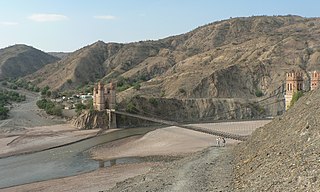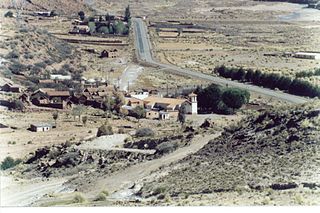| Jayaq Mayu | |
| River | |
| Name origin: Quechua | |
| Country | Bolivia |
|---|---|
| Region | Potosí Department |
| Source | Cerro Rico |
| - location | Potosí Municipality |
| Mouth | Agua Dulce River |
| - location | Yocalla Municipality |
Jayaq Mayu (Quechua jaya pungency, locoto, mayu river, -q a suffix, "spicy river", hispanicized spelling Jayac Mayu) [1] is a Bolivian river in the Potosí Department, Tomás Frías Province, in the south of Potosí. It originates on the west side of the mountain Cerro Rico or P'utuqsi Urqu located in the Potosí Municipality. Then it flows in a north west direction until meeting Agua Dulce River in the Yocalla Municipality. This river shortly afterwards forms the Tarapaya River at its confluence with Ribera de la Vera Cruz. Jayaq Mayu belongs to the Pillku Mayu drainage basin.

Pungency is the condition of having a strong, sharp smell or flavor that is often so strong that it is unpleasant; for example, the pungent smell of a dirty animal. Pungency is the technical term used by scientists to refer to the characteristic of food commonly referred to as spiciness or hotness and sometimes heat, which is found in foods such as chili peppers.

Capsicum pubescens is native to Bolivia and Peru and dates back to pre-Incan times, finding traces of its presence in the Guitarrero Caves. The existence of Capsicum pubescens was documented by ancient Peruvians of the Paracas, Nazca, Moche, and Chimu cultures, through textiles, ceramics, and domestic remains. This chili pepper is the most important ingredient of the Bolivian sauce llajwa. It is also considered the flagship of Peru and it is consumed fresh, paste, dried, or ground. It belongs to a species of the genus Capsicum (pepper), and is known in Peru and Ecuador as rocoto, locoto in Bolivia and Argentina and as the manzano pepper in Mexico which means 'apple' for its apple-shaped fruit. This species is found primarily in Central and South America, and is known only in cultivation. The species name, pubescens, means hairy, which refers to the hairy leaves of this pepper. The hairiness of the leaves, along with the black seeds, distinguish this species from others. As they reach a relatively advanced age and the roots lignify quickly, sometimes they are called tree chili. Of all the domesticated species of peppers, this is the least widespread and systematically furthest away from all others. It is reproductively isolated from other species of the genus Capsicum. A very notable feature of this species is its ability to withstand cooler temperatures than other cultivated pepper plants, although it cannot withstand frost.
In linguistics, a suffix is an affix which is placed after the stem of a word. Common examples are case ending, which indicate the grammatical cased of nouns or adjectives, and verb endings, which form the conjugation of verbs.







